Pam Hawley Marlin
January 2022
The old courthouse stood proud in the middle of the square, tall and enduring as the community bustled around it. A witness to historic events, it saw the first automobile and the first electric lights. Time passed, and as the young community grew up around the old courthouse, it fell into disrepair and was unable to meet the needs of its growing community. For two decades the townspeople debated the destiny of the old courthouse, but in the end, progress won. The community demolished the old courthouse, forever cutting its ties to the past.
 The Alachua County, Florida Courthouse (1885-1961)
and the statue honoring the county's Civil War dead (1904). Florida Memory
Courthouse Square in 1897
The Alachua County, Florida Courthouse (1885-1961)
and the statue honoring the county's Civil War dead (1904). Florida Memory
Courthouse Square in 1897
Historically, "courthouse square" was the town's original center. The Alachua County courthouse, located in the middle of courthouse square in Gainesville Florida, was the center of political and judicial life. Large communal meetings such as political rallies, debates, parades, plays, and celebrations, were frequently held at courthouse square. Surrounded by businesses, pubs, houses, and churches, all routes led to the courthouse square where residents conducted business or bought and sold goods. Courthouse square was the heart of the community.
"Gainesville got its start all because of a courthouse. Not just any old courthouse, but the Alachua County Courthouse..." states a 1981 Gainesville Sun article titled, "Progress Severs Alachua County's Link to the Past." Long before a seat of Justice was established or a courthouse constructed, however, this area was known as "Inland Florida." Occupied by the Spanish and Native Americans, Florida was not considered safe for settlers, but settlers came anyway. By 1822, Florida became a U.S. Territory and two years later on December 29, 1824, an Act of the Territorial Legislative Council established Alachua County.
Prior to an official government site being established, all business was conducted at Wanton's, a trading post and lodging house located in present day Micanopy (1825). Shortly after Alachua County was created, however, local leaders decided to establish a new county seat. On November 15, 1828, the Legislative Council named "a place in said county usually called and known, as the courthouse head, eight miles southeast of the Natural Bridge on the Santa Fe River, and on United State's road, known as Bellamys' Road ... That said county site shall hereafter be called and known by the name Newnansville." Site accessibility was a contributing factor in the decision as Bellamy Road, a newly completed thoroughfare between St. Augustine and Pensacola, passed directly through Newsnanville (near present day City of Alachua), making it an ideal site for the new county seat. 1
Though Newnansville struggled with Native American hostilities and repairs to the deteriorating Bellamy Road, it was re-appointed as the Alachua County seat in 1839. Alachua County's first two courthouses were located in Newnansville, the first was a "little log courthouse" that was converted into a fort during the Second Seminole War in 1835. This courthouse was remodeled and two jury rooms added in 1847. In January 1850, the commissioners discussed the matter of building a new courthouse for Alachua County in the public square of Newnansville. Samuel W. Burnett provided the lowest bid and won the contract to build the new courthouse.1, 2
The following document, written by Samuel Burnett on February 5, 1850, list specifications for the new Newnansville courthouse. "This day the county commissioners awarded to me the contract of building a courthouse of the following dimensions and of the material herein after mentioned to wit a house forty feet square, two story high ... the second story to be 13 feet pitch 40 by 32 feet for courtroom sealed overhead with 3/4 inch boards draped and lounged and groomed a partition to separate the stairs from the courtroom." The specifications also stated that the courthouse was to be completed in nine months at a cost of $1,975.00. One county commission rule regarding the new courthouse was that "there would be no dancing in the building." 2 When the new courthouse was completed in 1852, the county gave permission for the old Newnansville courthouse, with the two jury rooms, to be removed from the Newnansville public square.
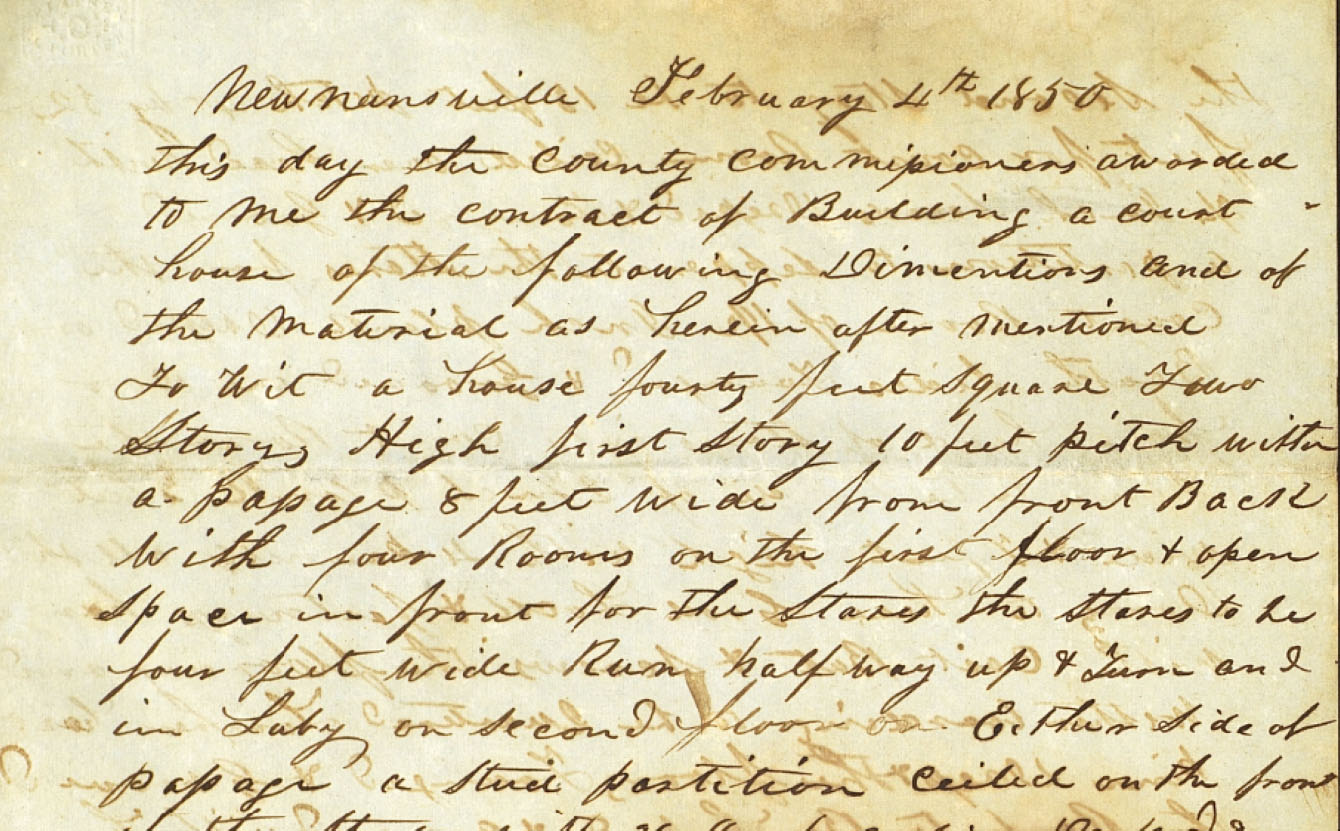 The specifications for the 1850 Newnansville, Florida
courthouse.
University of Florida Digital Collections
The specifications for the 1850 Newnansville, Florida
courthouse.
University of Florida Digital Collections
In 1850, the Florida Railroad Company revealed plans to build a line from Fernandina to Cedar Key. The new route, which passed through Alachua County, bypassed Newnansville several miles south. This led to a population increase in the southern part of the county. Shortly thereafter, Alachua County residents voted to create a new town on the railroad line for the county seat. Major James B. Bailey, a cotton plantation owner, former county treasurer, and proponent of relocating the county seat, sold sixty-three acres of his property to the county. The deed of sale, dated January 24, 1854, shows the property was bought by the county for $242.52.
Though property had been purchased for the new county seat, the new town had not been named. On September 6, 1854 the Alachua County Commissioners meeting, held in Newnansville, states, "A square to be reserved in the center, as near as may be, containing four acres, four main streets entering the square to be 90 feet wide. The other Streets to be 40 feet wide. The entire Town to be surrounded by a Street not less than thirty feet. The place to be named Gainsville."3 The first map of the Township of Gainesville was surveyed by Jessie R. Hunter. 14 An 1880 map provides an early glimpse of Gainesville.
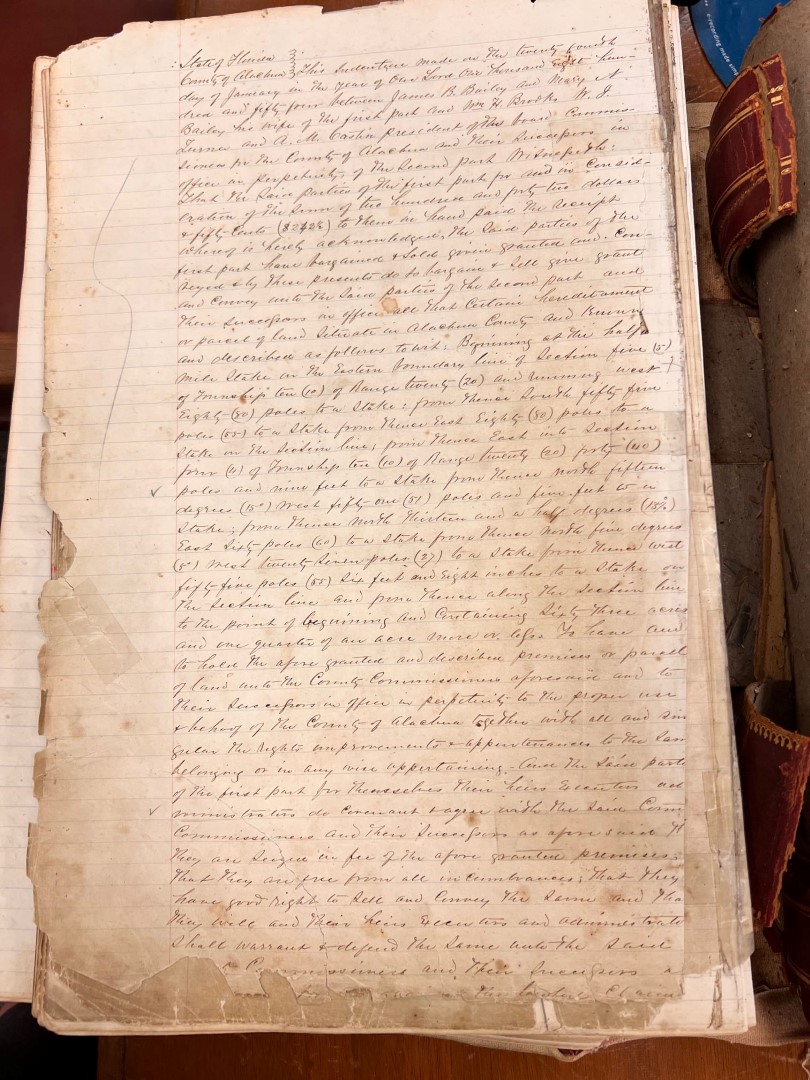 The original deed used to purchase a plot of land for the new courthouse
dated January 24, 1854. Alachua County Clerk office archive.
The original deed used to purchase a plot of land for the new courthouse
dated January 24, 1854. Alachua County Clerk office archive.
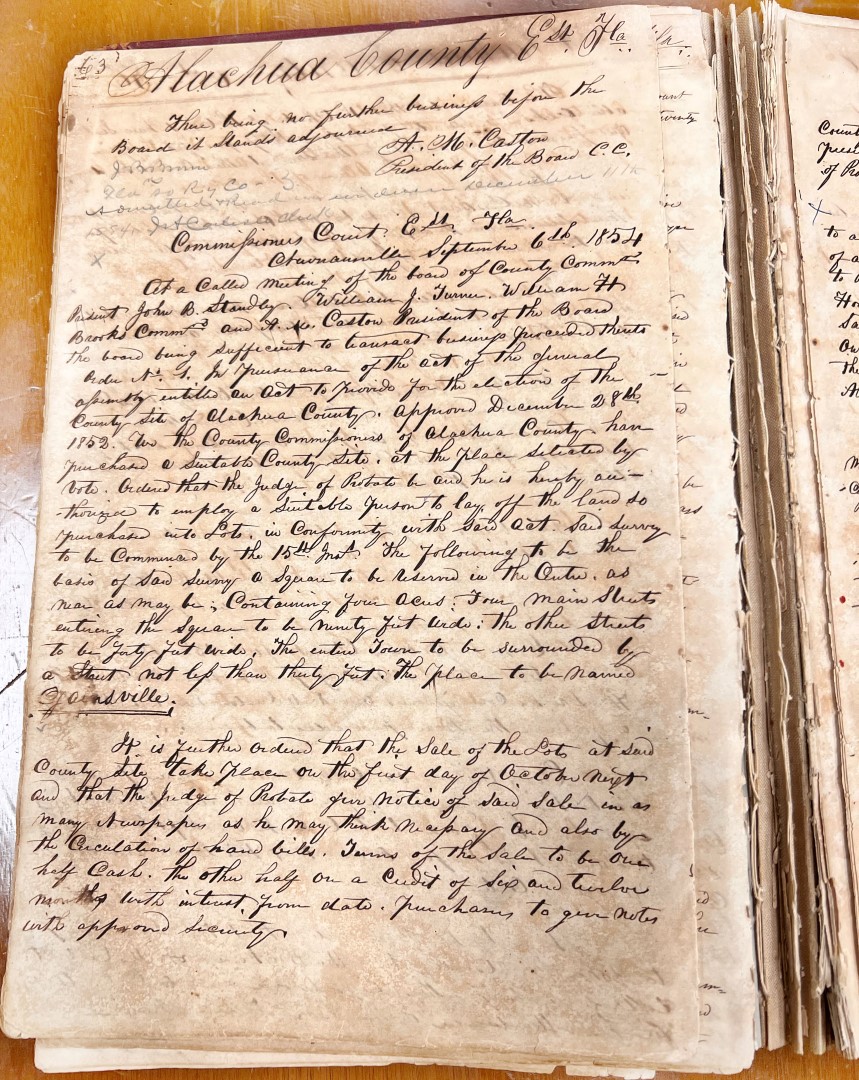 "The place to be named Gainsville" the original Alachua County Commissioners meeting minutes written in Newnansville on September 6, 1854, naming "Gainsville" (underlined) as the new county seat.
Scanned document: County Commission Minutes Book 1 Alachua County Ancient Records
"The place to be named Gainsville" the original Alachua County Commissioners meeting minutes written in Newnansville on September 6, 1854, naming "Gainsville" (underlined) as the new county seat.
Scanned document: County Commission Minutes Book 1 Alachua County Ancient Records
Upon selecting a site for the new Alachua County courthouse in the new town of Gainesville, the commissioners selected Tilman Ingram, a local contractor, to build the courthouse. Though Tilman won the bid at $5,500, the actual construction of the courthouse was completed by W.L. and Michael Finger. The Fingers were early settlers who had also constructed the first schoolhouse and first Prebysterian Church in Gainesville. They built the new courthouse in the middle of what would become known as "courthouse square."
Carl Webber's book, the Eden of the South provides details of Gainesville's courthouse square, "The principal streets of the city are East and West Main streets, running east and west, and Union and Liberty streets, running north and south. These intercept each other in the centre of the city, forming the public square before alluded to. Around this square are clustered the business places of the merchant kings of Alachua, from the doors of either one of which may be seen at a glance the proceedings in the entire square, excepting such portion as may be hidden by the great central object, the court-house." He continues, "This is the great trading mart of the county, and upon each Saturday this square is filled with the people from the surrounding country who come here to sell their products and to lay in their supplies for the following week. To strangers from the North this is a new and curious sight. Home-made vehicles of every description propelled by mules : lone cows harnessed with ropes into rudely-constructed shafts of primitive-looking go-carts, and driven, maybe, by a buxom- looking country girl in holiday attire..." 4
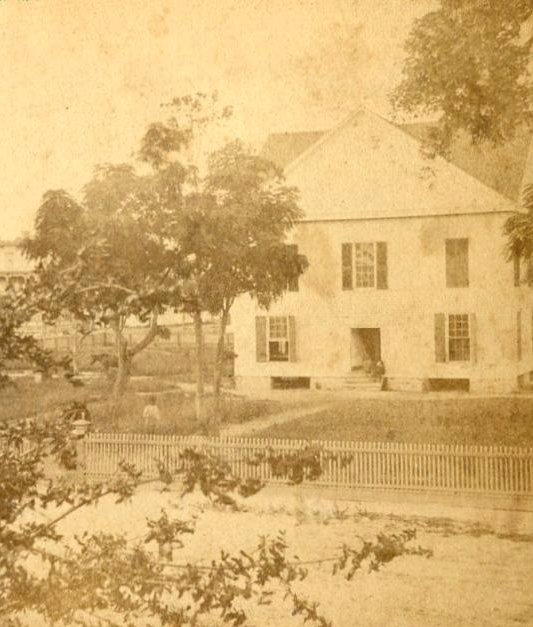 The first Gainesville courthouse (third Alachua County
Courthouse) built in 1856 and demolished in 1885.
Alachua County Library
The first Gainesville courthouse (third Alachua County
Courthouse) built in 1856 and demolished in 1885.
Alachua County Library
Completed two months early, Alachua County officials moved into the two-story, white clapboard building in December 1856. The new courthouse was similar to many of the large houses of the time. "It had a porch which jutted out from the entrance and around all four sides. Inside, corridors divided the bottom floor into four offices; where clerks handled the paperwork of the county. A steep flight of stairs led up to the large courtroom and two small jury rooms. The courthouse square became the center of activity for the small town of Gainesville. Unfortunately, livestock as well as people found it a pleasant place to congregate. In 1860, a fence was constructed around the square to prevent animals from wandering into the courthouse." 5 As courthouse square became the center of the county, judges, juries, and attorneys conducted daily business while locals bought and sold goods, attended festivals, listened to preachers or political debates ... and chased livestock. The square also had a well that supplied water for the horse trough. In March 1877, the first street lamps were erected around the square.
By 1883, the nearly thirty year old courthouse no longer met the needs of the community. Complaints about the lack of heating and wet weather creating mold on court records led to an 1883 grand jury presenting a report on the condition of the courthouse, "We find the Court House dilapidated in outside appearance, sadly needing paint, an architecutural eyesore, the shed leaks in rainy weather, the plastering is broken in places, glasses and sashes, floors and walls filthy and the whole building pervaded by a sick odor." 6 A letter to the Editor posted in the 1883 Alachua Advocate suggested that "the courthouse question was one of serious importance."
 A letter to the Editor on May 30, 1883. Alachua Advocate
A letter to the Editor on May 30, 1883. Alachua Advocate
In an act that repeated itself nearly eighty years in the future, commissioners suggested that the present courthouse be torn down and the land it resided on, courthouse square, be sold for commercial use to pay for a new courthouse. All indications were that the new courthouse would be moved to a new location, adjacent to the county jail. The benefit of this plan was to avoid incuring debt to build a new courthouse, however, the plan did not succeed. The final decision was to build the new courthouse on existing land, thus preserving courthouse square.
In 1884, cotton buying, ginning, moss treating, iron works, and citrus were Gainesville's primary industries. Businesses such as H.F. Dutton & Co. a cotton ginning company, the Doig & Harris Foundry and Machine Works, and Leighton Bros. and Green saw mills, were all located on Main Street. The fragrant smell of citrus hung in the air as twenty acres of orange groves surrounded courthouse square. As plans for a new courthouse to support a growing community took shape, the old white clapboard courthouse was moved to accommodate building the new one.
According to a 1981 Gainesville Sun article, "Progress Severs Alachua County's Link to the past," construction on the new courthouse began in October 1884. "One of its [courthouse] contractors, H. Murphy, had 100 car loads of material delivered in December 1884. The walls of the new building were 3 feet 6 inches thick. Ten masons worked on it, laying an average of 30,000 bricks a day. The cornerstone was laid on February 22, 1885. The roof was covered with eight tons of lead. On its peak soared an American Eagle."6
The Victorian style courthouse was built at a cost of $50,000. A two story red-brick building, it had an entrance on each side, with the north and south entrances featuring a copper lion. Gables and a soaring eagle above the clock tower gave the courthouse a majestic appearance. The interior bottom floor was divided into rows of officees by corridors running north-south and east-west. The upstairs courtroom had a gallery for spectators and a single jury room adjoined the county commissioner's meeting room, completing the second floor.
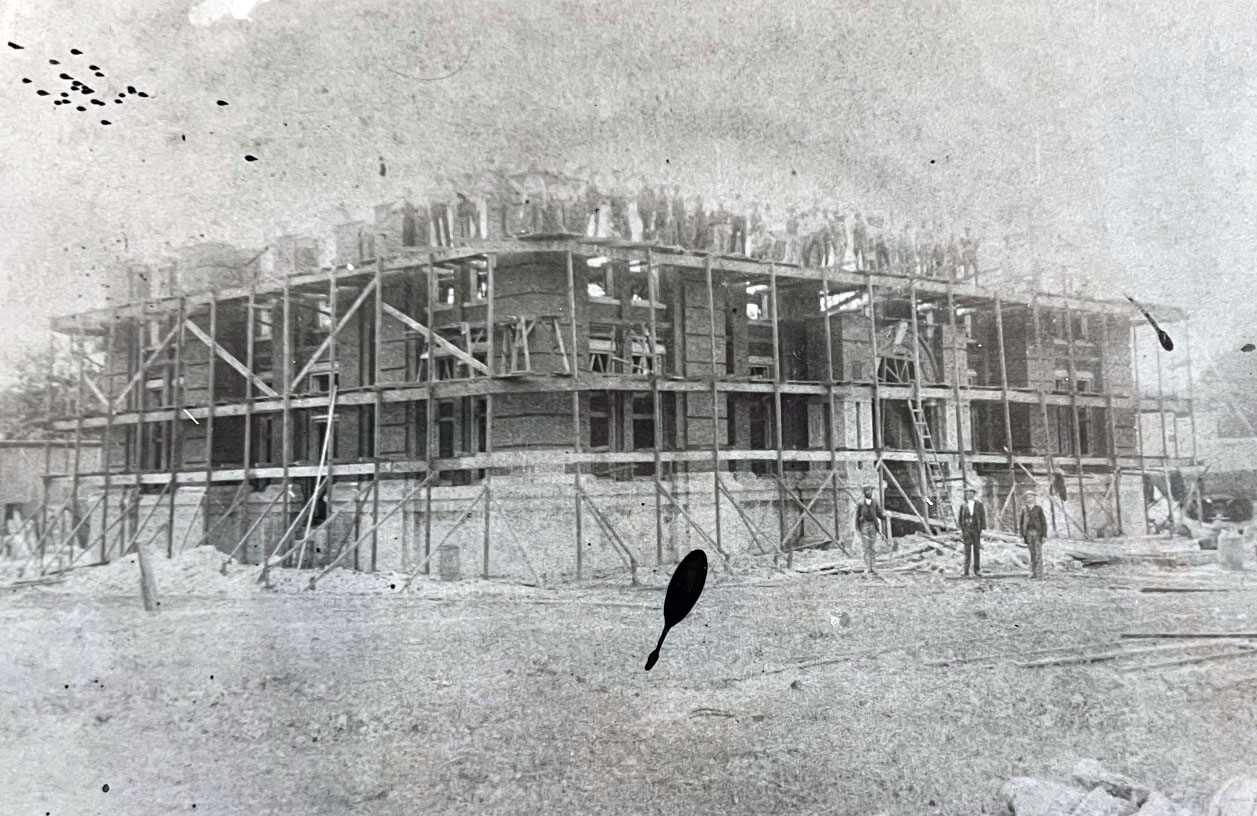 The new courthouse in 1885. Matheson Museum
The new courthouse in 1885. Matheson Museum
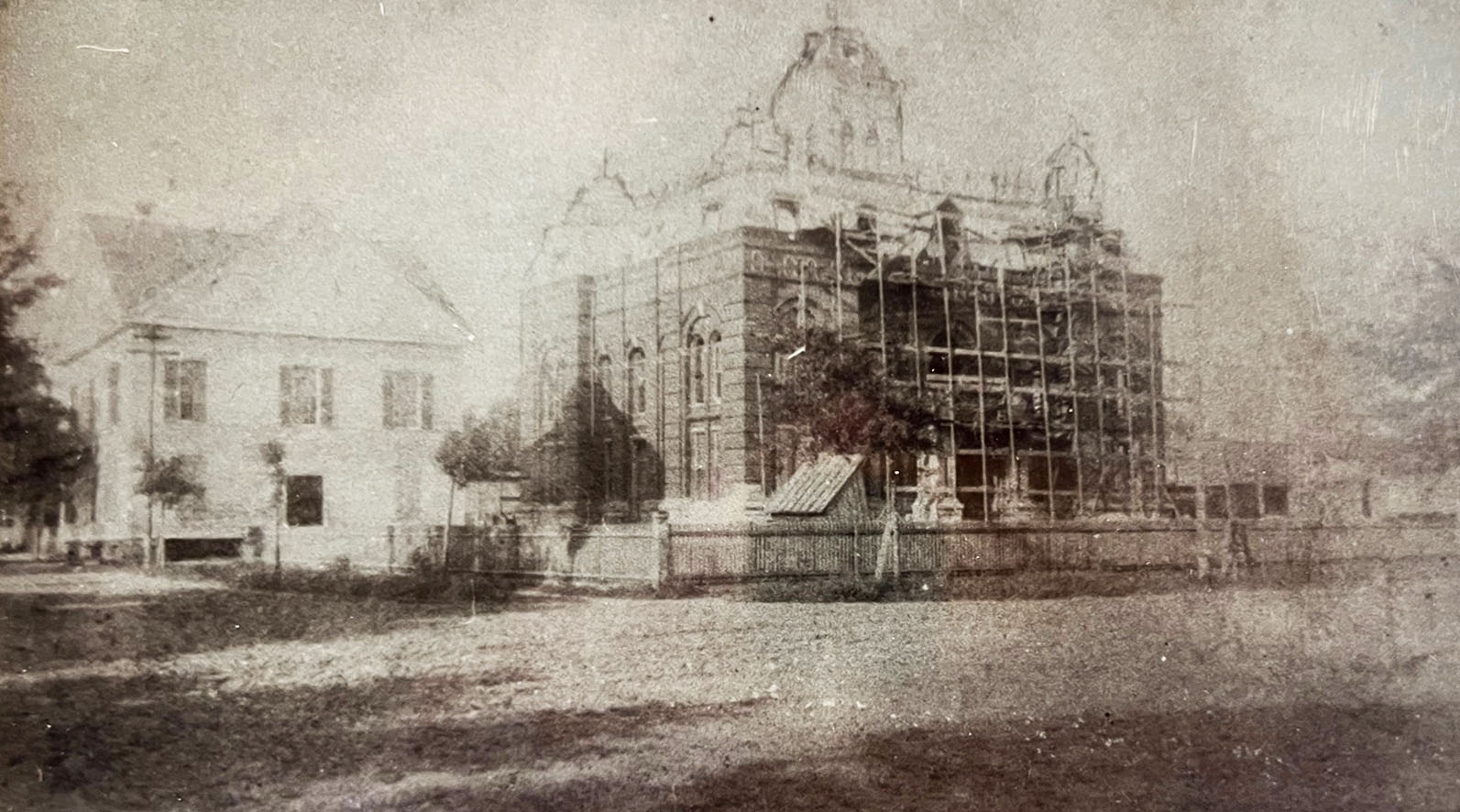 The second Gainesville courthouse being built next to the first courthouse. Matheson Museum
The second Gainesville courthouse being built next to the first courthouse. Matheson Museum
World wide social, economic, and cultural changes had their influence in Gainesville over time and many of those changes evolved around events that occured at the courthouse and courthouse square. For example, after being shot by Elbert Hardy, who was hailed as a hero by the sheriff on the courthouse steps, renowned felon Harmon Murray's body was deposited on the courthouse grounds in 1891. In 1903, a young man by the name of Booker T. Washington spoke to nearly 2,000 people in courthouse square. A statue honoring the county's Civil War dead was erected in 1904. The first electric lights lit up the courthouse square in 1915. Imperial member of the Ku Klux Klan, Hiram Wesley Evens, spoke in 1936. An invasion of privacy trial was held against local author, Majorie Kinnan Rawlings in 1946. The 1950's brought displays of World War II artifacts including Hitler's car and a Kamikaze plane, marking the end of the World War II era. Speeches by politicians, including Florida Senator George Smathers brought political influences.
Jim Clayton, a Gainesville lawyer who worked in the grand courthouse as a young man, was a regular contributor to the Gainesville newspaper, The Record, published in the 1990's. In his writings, Clayton provides perhaps the best description of the courthouse and square in its early years. "You could hear the clock in the tower all over town, striking each hour. Gave one sort of a sense of community - of belonging so to speak. The building, the tower, the clock; they belonged to everybody. I miss the old courthouse. I don't recall the huge doors at the four entrances ever being closed. They opened into wide corridors whicih intersected at the center of the building where the grand staircase and the ancient elevator were located. You could stand at the intersection of the corridors, turn slowly in a circle and see right out of the building - in every direction."
"All of the constitutional officers in that one building. The County Judge, the Clerk of the Course, the Sheriff, the Tax Appraiser, the Tax Collector, and the School Superintendent. The names and titles of all the officers were printed in gold gilt on the big glass doors of their offices, all of which opened out on the corridors. The floor was black and white tile - like most bathrooms in those days. The wood staircase was almost black, probably mahogany, and the railings were carved pretty fancy."
"The courthouse square was the center of town. Not only was it the place to watch the Atlantic Coast Line trains chug slowly down Main Street, it was also the place to draw a crowd, particularly during state and national elections. Political rallies were big then, much more so than now, and people really turned out for them. The old court house made a great backdrop, and there was usually a string band to go with the speeches and television was not around to keep people at home."
 The Alachua County courthouse in 1885. Notice the lion above the doorway
and the eagle on the roof. The metal roof, deemed to
heavy, was replaced and the curves altered slightly after
1900. Matheson Museum
The Alachua County courthouse in 1885. Notice the lion above the doorway
and the eagle on the roof. The metal roof, deemed to
heavy, was replaced and the curves altered slightly after
1900. Matheson Museum
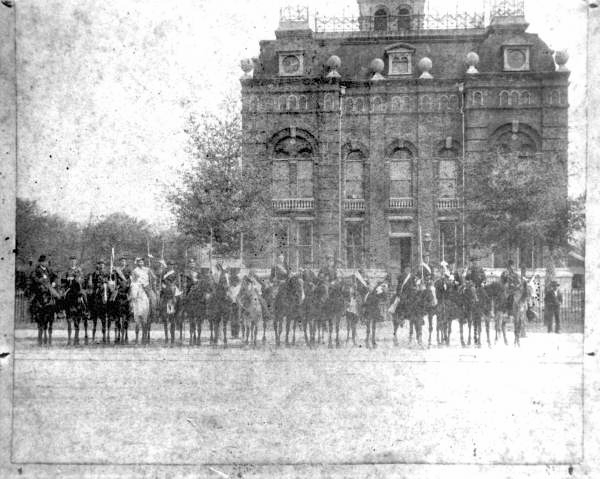 The Gainesville Guards posed for this
photograph in 1885, just after Alachua County's new
courthouse was finished. The Guards, which included many of the
city's socially-prominent men, wore decorative uniforms, sashe
s across their chests, and were armed with javelins or lances which seated in sockets at stirrup level.
Florida Memory
The Gainesville Guards posed for this
photograph in 1885, just after Alachua County's new
courthouse was finished. The Guards, which included many of the
city's socially-prominent men, wore decorative uniforms, sashe
s across their chests, and were armed with javelins or lances which seated in sockets at stirrup level.
Florida Memory
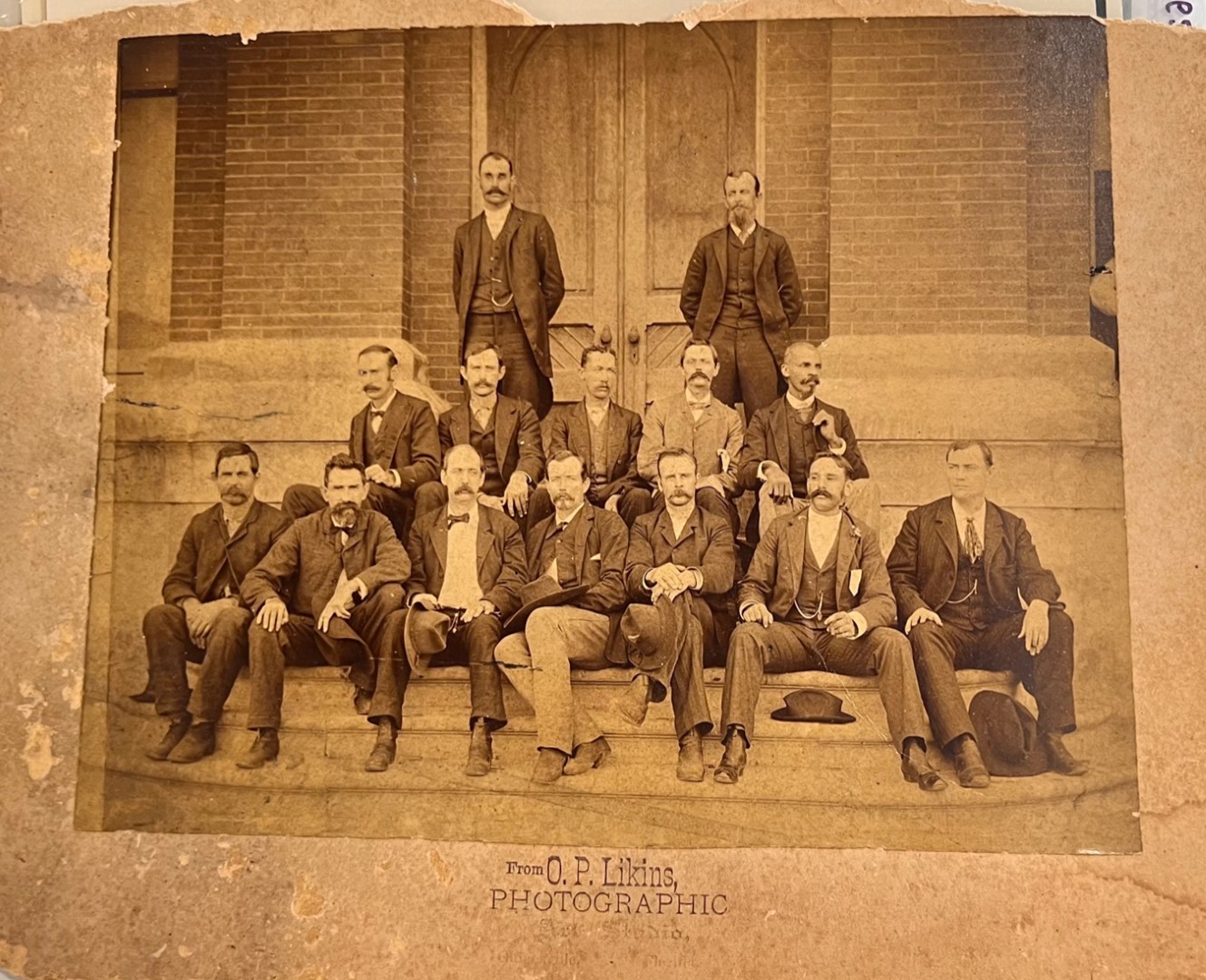 A group of men pose on the steps of the courthouse. Matheson Museum
A group of men pose on the steps of the courthouse. Matheson Museum
 Florida Southern's tracks ran along
Main Street. In 1811, a local ordinance granted this
right-of-way in and limited speed to four miles per hour within
limits of the town. A ringing bell warned residents
of the coming train. For many years no dining cars were carried, and the
train stopped at the Gainesville Station for one hour so that
passengers could enjoy luncheon at the White House Hotel.
University of Florida Digital Collections
Florida Southern's tracks ran along
Main Street. In 1811, a local ordinance granted this
right-of-way in and limited speed to four miles per hour within
limits of the town. A ringing bell warned residents
of the coming train. For many years no dining cars were carried, and the
train stopped at the Gainesville Station for one hour so that
passengers could enjoy luncheon at the White House Hotel.
University of Florida Digital Collections
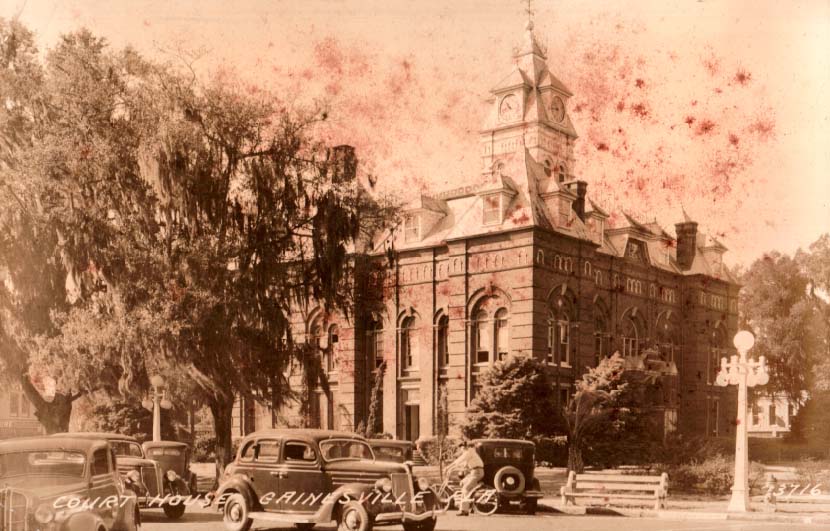 Alachua County Courthouse in 1930.
University of Florida Digital Collections
Alachua County Courthouse in 1930.
University of Florida Digital Collections
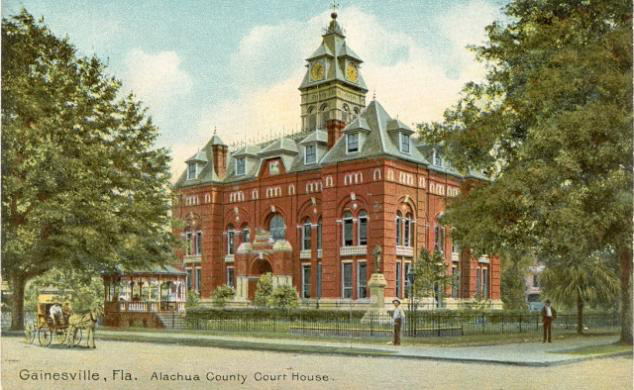 Alachua County courthouse, Gainesville, Florida postcard.
Alachua County courthouse, Gainesville, Florida postcard.
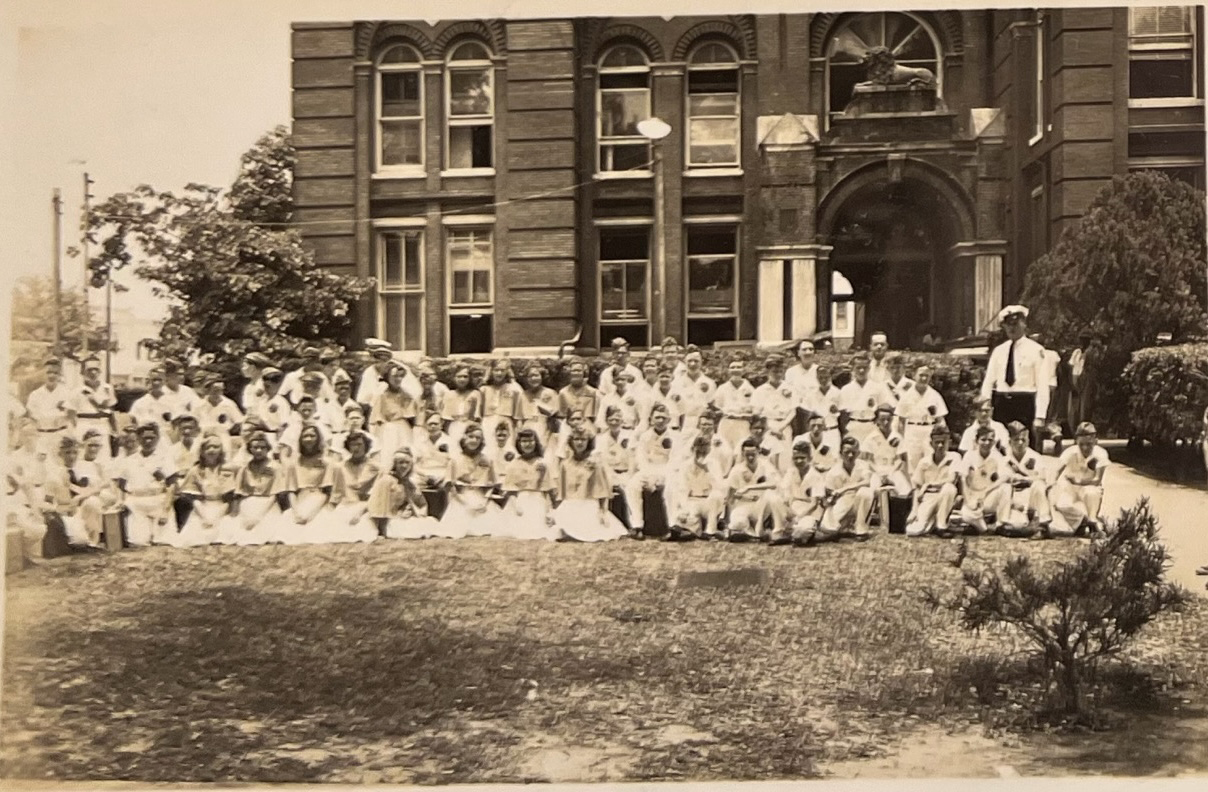 A group poses in front of the courthosue. Matheson Museum
A group poses in front of the courthosue. Matheson Museum
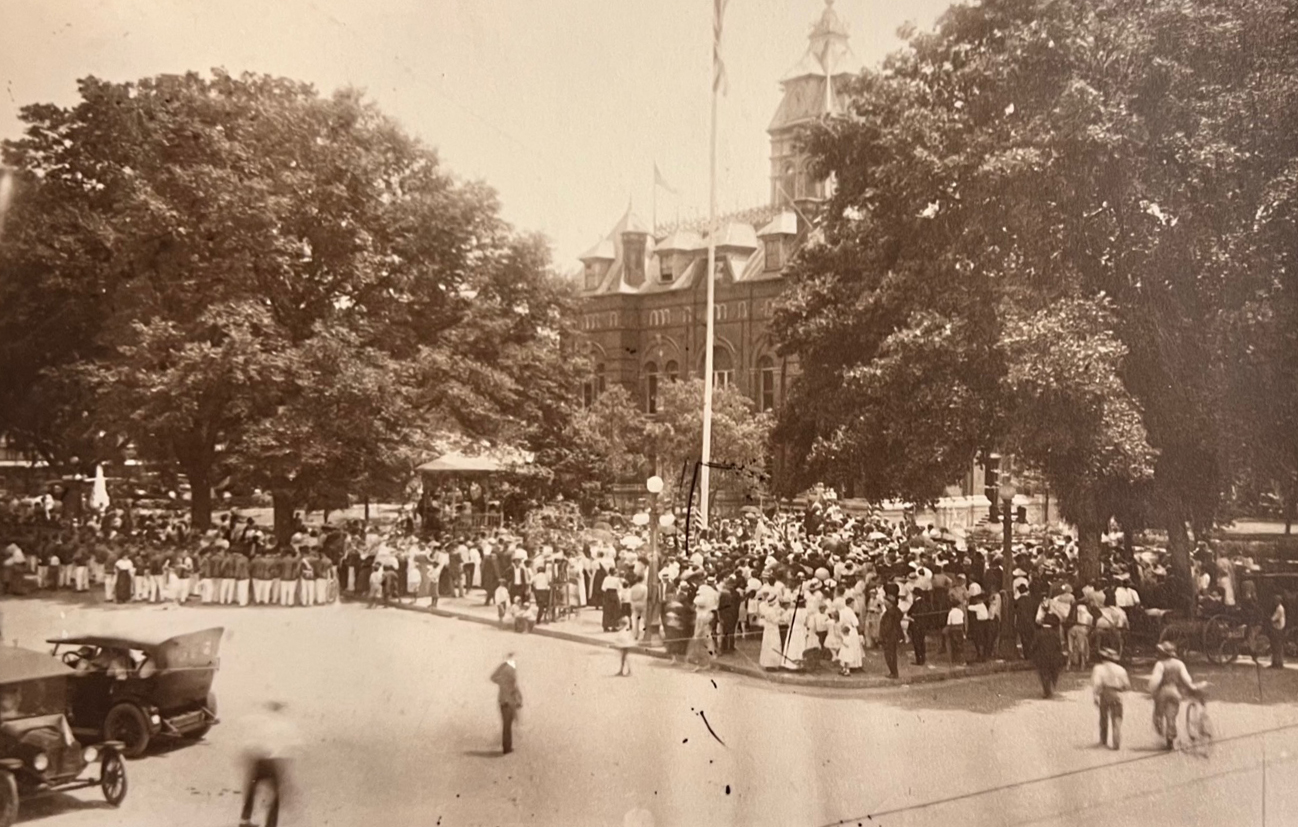 Courthouse event, possibly a July 4 celebration. Matheson Museum
Courthouse event, possibly a July 4 celebration. Matheson Museum
Inevitably, criticisms regarding the deficiencies of the courthouse surfaced. In 1936, a grand jury recommended changes to the courthouse, "All of the departments and offices have been found to overcrowded, a number of them have no adequate vault facilities for the protection of public records; which could not be replaced in case of fire."7 In 1945 a local attorney, Sam W. Getzen of the Eighth Judicial Bar Association, prompted a meeting of local officials and representatives to discuss the "courthouse question."The Bar Association favored a courthouse "in size and facilities that will not only take care of present conditions, but also take into consideration the future growth of the county."7 The same year, a "sinking fund" was proposed by the Gainesville Chamber of Commerce to fund a post war building program. A committee was organized and recommendations for input from engineers and architects was made. Getzen proposed two funding methods for building a new courthouse, 1. Putting up a millage, allowed by law up to 5 mills for 15 years; and 2. Selling the courthouse and use the money to build a new one.
In 1946, F. Author Hazard, a local architect, appeared before the County Commissioners to discuss proposed plans for a new courthouse, "Strongly advocating a new, modern building, Hazard said that the cost of remodeling would be heavy as the entire inner construction would have to be torn out, present window designs changed, and exterior walls extended to provide more room." The overall problems were, "lack of space for clerical work, inadequate heating, outmoded electrical wiring, unsatisfactory storage room, and the lack of private offices." 8
In 1952, the Bar Association again pressed community leaders for a new courthouse proposing the new courthouse be built in a new location and courthouse square sold for commercial purposes to pay for it. In response, the County Commissioners established a "courthouse study" consisting of a six man committee appointed to work with the commission on securing estimates for either remodeling the present courthouse or building a new one. The committee consisted of attorneys Sam T. Dell, and Sam W. Getzen, local residents Addison Pound and Pat Keeter, and Clerk of the Court George Evans.
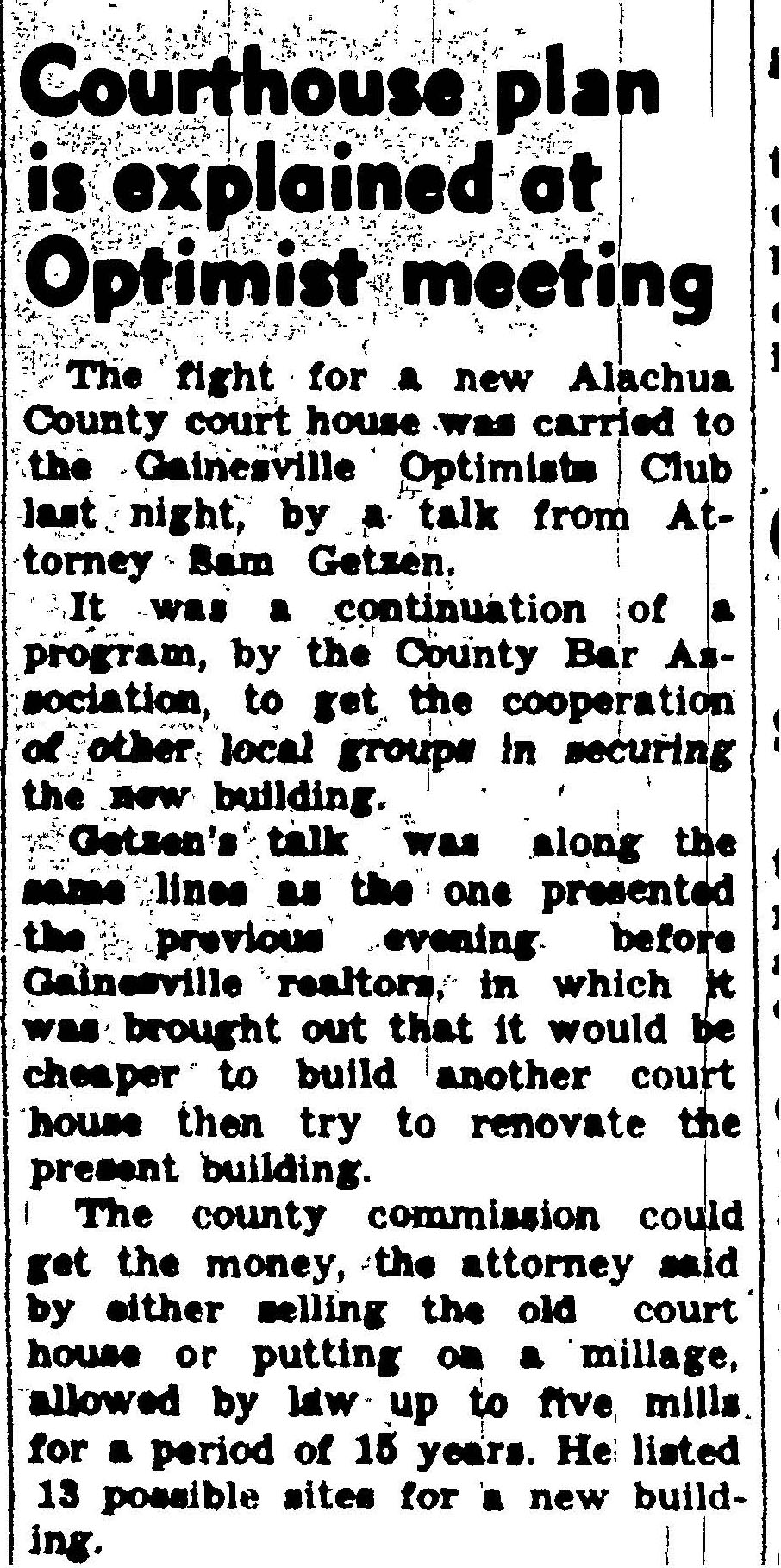 Gainesville Sun July 18 1952.
Gainesville Sun July 18 1952.
With their livelihood at stake, local businesses opposed to moving the courthouse presented the commissioners with a petition encouraging them to "enlarge and remodel the present courthouse if more office space was needed." Addison Pound, one of the six committee members, representing citizen tax payers who were not in favor of any proposition to move the courthouse site, wrote "we have worked and sweat blood to pay our taxes and we don't want to see a depreciation of values with some wild idea."9 The debate was just heating up.
Overcrowding at the local jail, hospital funding, post office renovations, and downtown parking shortages were all issues facing county commissioners in the 1950's. In February 1953, a courthouse survey revealed that the cost of a new courthouse was estimated at $800,000. Commissioner J. O. Todd thought the only solution to the county's problems was to sell the courthouse property and build a new courthouse at another location. He made a motion that the county would entertain offers to sell courthouse square in an effort to help pay for the new courthouse. Local architect Sanford Goin, along with other architects provided the estimate based on a courthouse survey, "Such a building would approximate $800,000 architectural and engineering fees." Goin also agreed that the present courthouse could not be remodeled economically, even stating later that, "Section 104 of the Uniform Building Code" prevented "alteration or repair of existing building without conforming to requirements for new building." 10
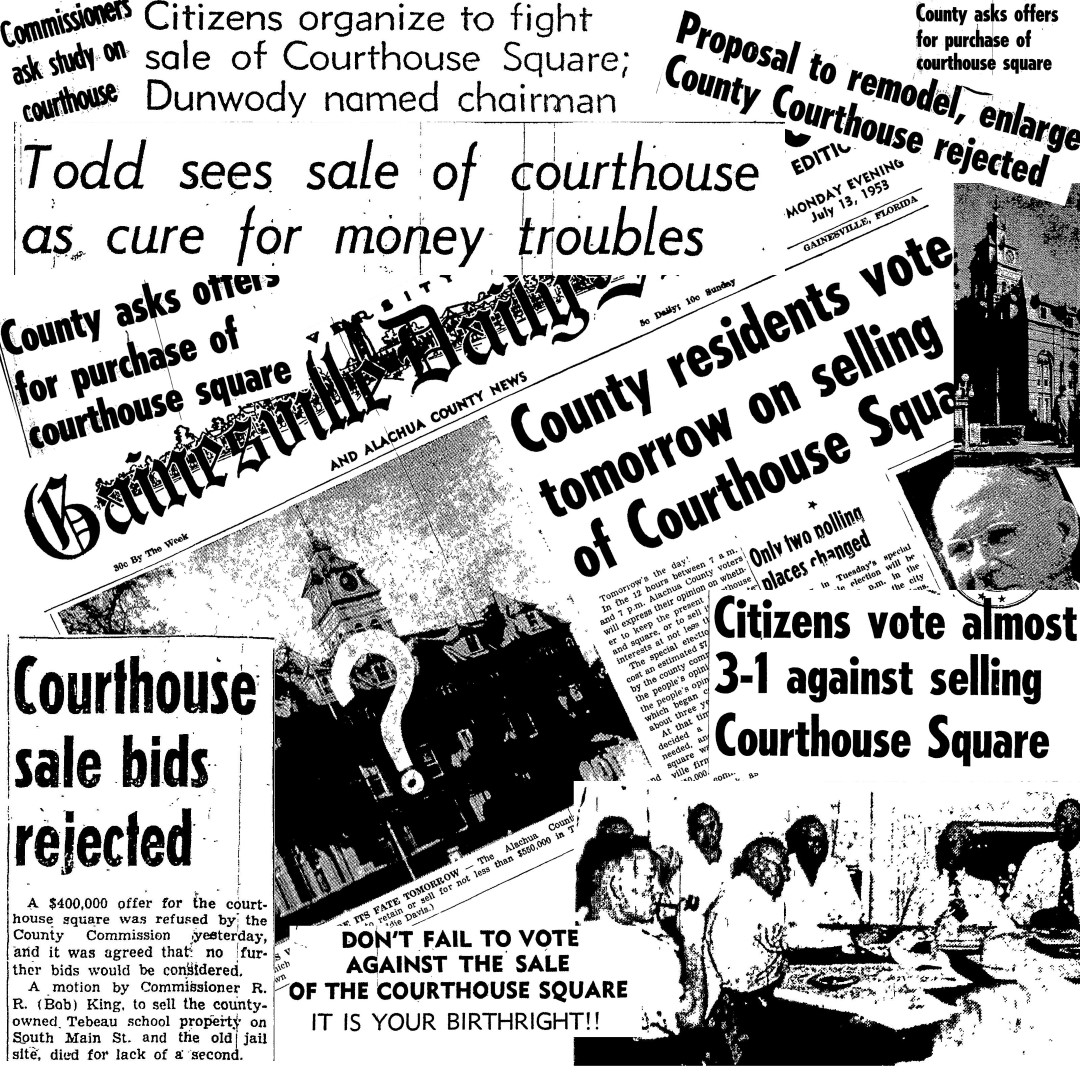 A selection of 1953 Gainesville Sun headlines.
P Marlin
A selection of 1953 Gainesville Sun headlines.
P Marlin
Goin presented two plans, the first, which was initially rejected by the commissioners, was to construct the new courthouse next to the old courthouse so the older building could be used until the other was complete. The second plan was to demolish the old courthouse and build the new one on the center of the square. A motion was made by Commissioner J.O. Todd for a "special election at full cost" to be held on July 14, 1953 to determine public sentiment as to whether or not to sell the courthouse square property. Prior to the July 14th vote, local businessmen who "believed in the continued growth of Gainesville and Alachua County" prepared a document titled, The Case For and Against the Sale of the Alachua County Courthouse."11 and a Citizens Committee, headed by chairman Jim Dunwoody, was organized to fight the sale of courthouse square. A few days prior to the vote, 250 concerned citizens filled the courthouse to hear opposing views on the sale. In the end, the official resident vote recorded 1,340 votes for the sale and 3,736 against.
In April 1955, the Bar Association presented the results of a study to the Commissioners in an effort to get a new courthouse built as soon as possible. Sam Getzen, as spokesman of the association, said the committee "found the courthouse to be entirely and completely inadequate to house the country's business and carry on and safeguard the county records and functions."12 The present courthouse was also in a deplorable state of repair.
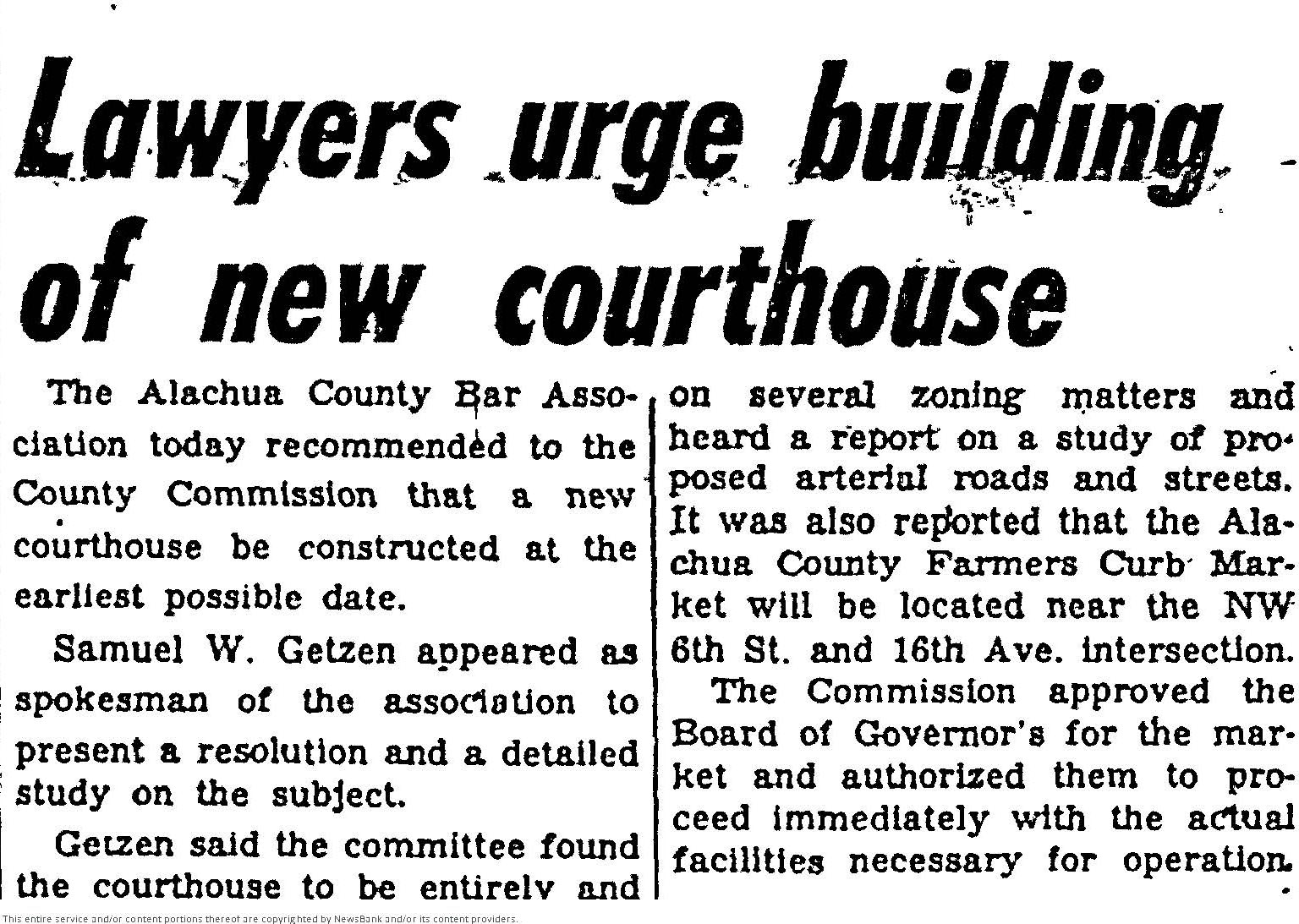 Gainesville Sun April 5, 1955
Gainesville Sun April 5, 1955
On June 7, 1955, the Courthouse Committee appeared before the County Commissioners and read a report provided by the committee members stating their recommendation and findings on a means of addressing the crowded courthouse. The committee also suggested that it was not economical to remodel the old courthouse or add to the present building. They further recommended that the new courthouse should be constructed on the old jail property site. All courthouse committee members, Barney Colson, Hershel Haynes, Johnny Brasington, George E. Evans, and Sam Getzen, approved the report. The one exception was committee member Pat C. Keeter, who disapproved the report, and provided his own minority report. Full Report
At the same meeting, Commissioners J.M. Galbraith, Jack Durrance, J.O. Todd, R.R. King, and W.J. Whitehurst voted unanimously to construct a new courthouse. The method to which to pay for the courthouse was still to be determined, as such, the commissioners then voted for the referendum to which three proposals would be used. The following is the commission meeting minutes from June 7, 1955.
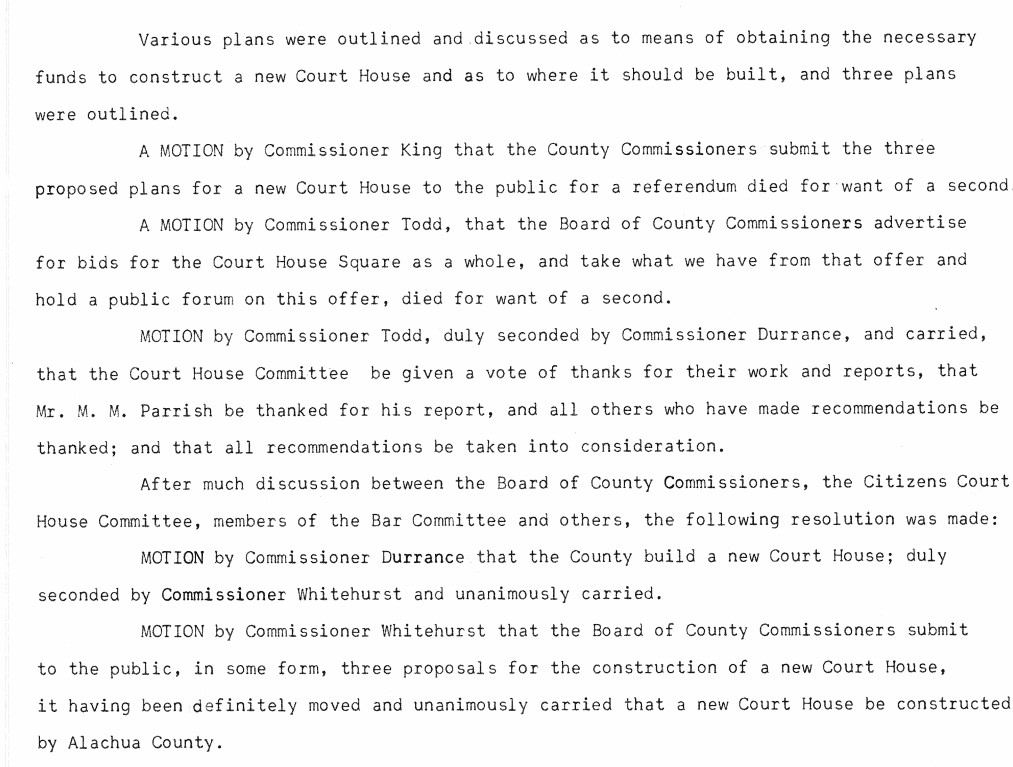 Alachua County Commission meeting minutes June 7, 1955.
Alachua County Archives
Alachua County Commission meeting minutes June 7, 1955.
Alachua County Archives
Three courthouse proposals were presented at the June 7, 1955 meeting: 1. Dismantle the present Courthouse building and construct a new building on the present Courthouse site. The anticipated cost of the new building was estimated to be $1,000,000. This would increase the millage approximately 2 1/2 mills per year, for a fifteen year period; 2. The 60-40 plan. Sell the North one hundred and forty feet of the present Courthouse square and use the proceeds from such a sale in the construction of a new courthouse on the remaining southern portion of the square; it was anticipated that the sell of the North one hundred and forty feet would provide additional funds. This was the plan that would provide additional downtown off-street parking; 3. Sell courthouse square in its entirety at a price not less than $700,000.00 and construct a new courthouse on the old county jail site.
As the summer of 1955 heated up, so did the debate over a new courthouse. A Jaycee sponsored public forum on July 7, 1955 included a five member panel that discussed alternatives on what to do with the square and building. Preserving the old courthouse was not out of the question as Sidney Godwin, a Hawthorne insurance agent, argued for remodeling the present courthouse. Local realtor and contractor, M.M. Parrish, advocated the 60-40 plan as the most economical, and Sigsbee Scruggs, local attorney, favored selling the square and building on the old jail land in southeast Gainesville.
At the same public forum, Sanford Goin, local architect, presented a new plan. The four point "Goin Plan" provided funds toward a new courthouse without additional taxes: 1. Remodel the present courthouse to house all county offices not needing maximum fire protection; 2. Removal of all other offices needing this fire protection to a new courthouse to be constructed elsewhere in the city; 3. Enlargement of the new courthouse when the county can afford it and removal of the remaining offices to the new building; 4. Destruction of the present courthouse at that time and retention of the Square as a public park.
 Gainesville Sun June 8, 1953
Gainesville Sun June 8, 1953
A funding shortage prompted commissioners to delay the courthouse plan until until November 1. At that time, C. Addison Pound and Pat C. Keeter (members of the courthouse committee but acting as private citizens), presented a new "pay-as-you go" plan to the Commissioners. The Pound-Keeter plan called for 1. Utilizing funds from the Courthouse sinking fund plus proceeds from the sale of county owned Tebeau property (located near the courthouse), plus additional funds accuring to the sinking fund for additions to the present courthouse and 2. Design an addition to either the front or side of the present courthouse to meet expanding county government needs and eliminate the present necessity of paying for private office space for many county offices. The pay-as-you-go concept called for the development of additional facilities in a separate structure next to the main building. As a result, more space can be built as the county can afford it.
Finally, in February 1956, county commissioners agreed to a courthouse plan that adopted essential elements from both the Goin plan and the Pound-Keeter plan. The approved "U-shaped" courthouse called for three additional units to be built on courthouse square. The building of the first addition would begin before the end of the year, and the additional units would be built as funding became available. There was also a call for minimal improvements to the existing courthouse. Once the second unit was complete, the seventy year old courthouse would be demolished. In July, with preliminary drawings in hands, the commissioners tasked the firms of Campbell, O'Kelley, and May and Pierson and Dirks to proceed with final construction drawings. The commissioners commented on the "functional-modernism" look of the new building. The Bar Association criticized the first addition as not providing space for the future needs of the county. Five months later, construction began on the first addition with M.M. Parrish Construction awarded the building contract. After twenty years of discussion, the new Alachua County courthouse would be built at the same location, again preserving courthouse square.
On February 5, 1958, the County Commissioners accepted the completion of the first unit of the new county courthouse. The old courthouse's days were numbered.
 Gainesville Sun July 4, 1956
Gainesville Sun July 4, 1956
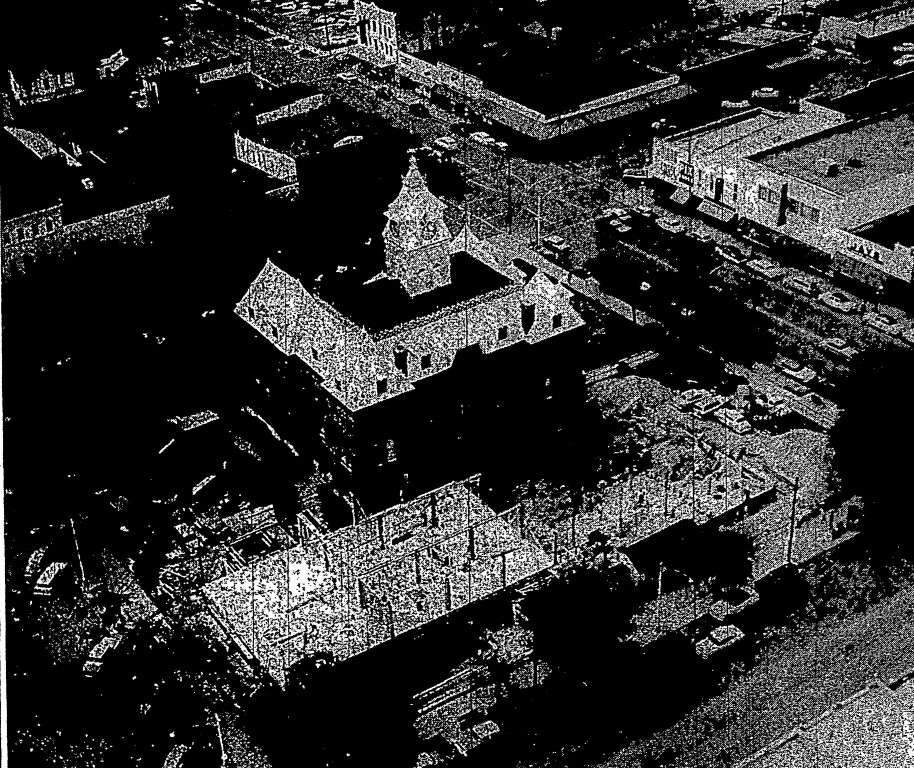 Aerial view of the old courthouse with the
new addition. Gainesville Sun March 24, 1957
Aerial view of the old courthouse with the
new addition. Gainesville Sun March 24, 1957
In May 1961, plans were made to relocate workers and equipment from the old courthouse. A month later, commissioners began accepting bids for razing the old courthouse. The antique clock that had kept time for seventy-six years on top of the courthouse was saved, but no one was interested in rescuing the tower where the clock was located. Commissioners approved the sale of the courthouse safe (purchased by J.R. Crane for $15.00), the sale of the courtroom chairs, and the moving of all courthouse records to Alachua General Hospital for temporary storage. On August 2, county commissioners accepted a bid of $3,333.00 from P.L.Buchhalter & Co. of Jacksonville, to demolish the courthouse.
 Gainesville Sun. August 27, 1961. Matheson Museum archive
Gainesville Sun. August 27, 1961. Matheson Museum archive
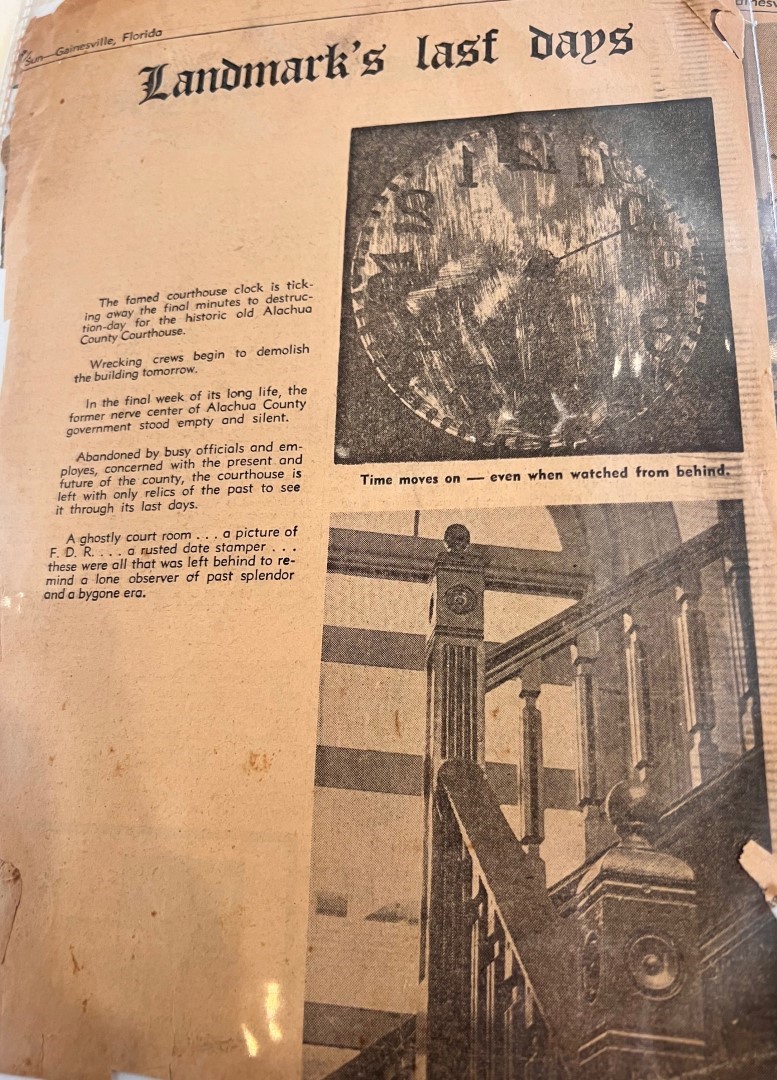 Gainesville Sun. August 27, 1961. Matheson Museum archive
Gainesville Sun. August 27, 1961. Matheson Museum archive
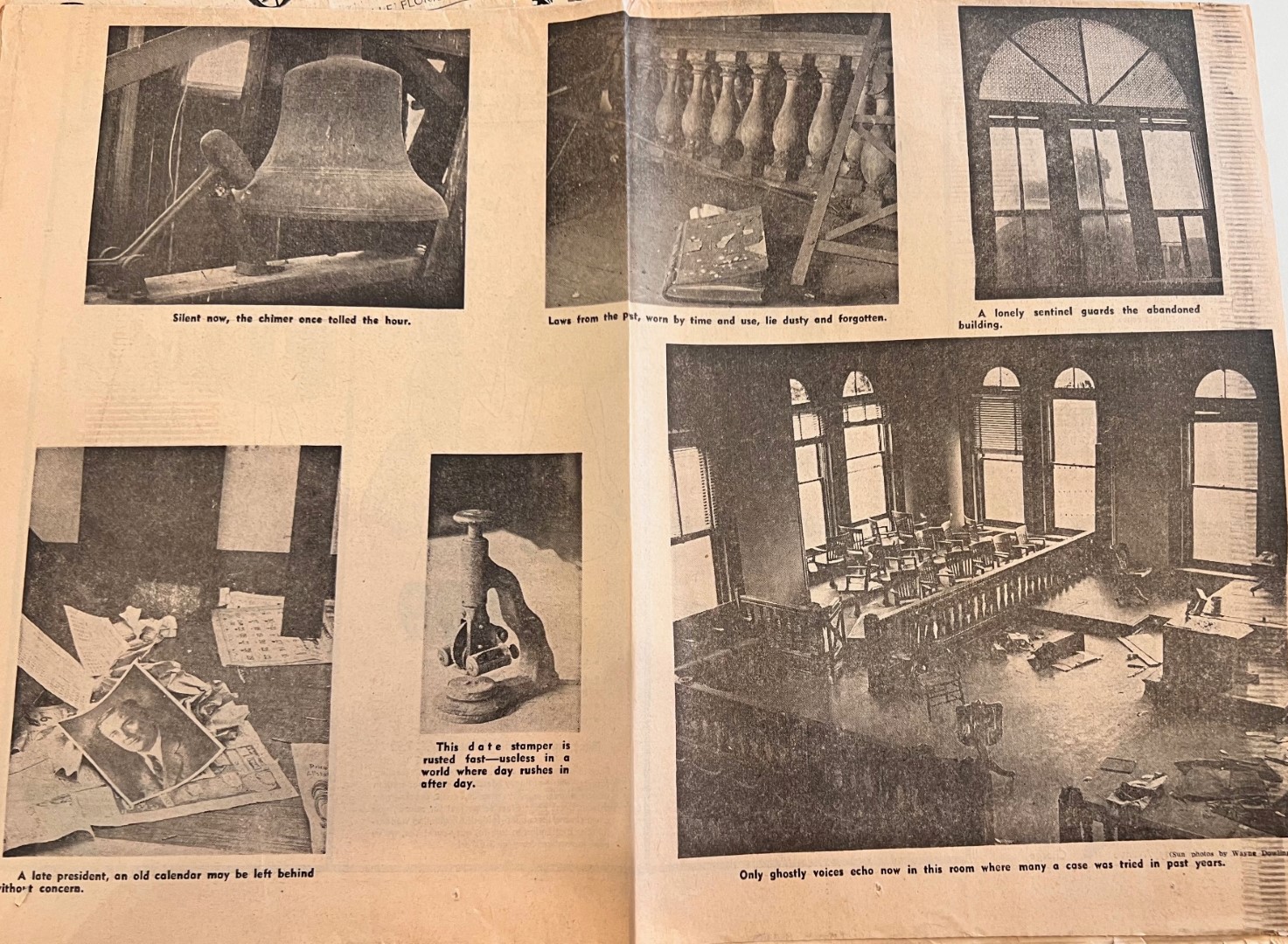 Gainesville Sun. August 27, 1961. Matheson Museum archive
Gainesville Sun. August 27, 1961. Matheson Museum archive
 Courthouse demolition 1961. E.H. Bone photography
University of Florida Digital Collections
Courthouse demolition 1961. E.H. Bone photography
University of Florida Digital Collections
 Courthouse demolition 1961. E.H. Bone photography
University of Florida Digital Collections
Courthouse demolition 1961. E.H. Bone photography
University of Florida Digital Collections
As daily headlines shifted to acquiring funds for the new courthouse additions, dismantling of the old courthouse received little attention. On November 8, 1961 the Gainesville Sun reported the discovery of an antique copper tin box inside the courthouse's cornerstone. Commissioners Edgar Johnson and Jack Durrance were called on to inspect the contents. The cornerstone, laid on February 22, 1885, included "copies of the Alachua Advocate dated January 30, 1885 and February 6, 1885, copies of the Daily Item of Ocala, the Florida Dispatch of Jacksonville and the Palatka Daily News. Coins from 1804 to 1885, including four quarters, two dimes, eight nickels, nine pennies and six foreign coins. A large and small arrowhead. A $100 and a $10 Confederate bill [too damaged to be of any value]. A scrap of paper signed by Mr. J. W. Williams of Archer. The business card of Burke & Guy "contractors for plain and ornamental plastering." The business card of Jos. Voyle, civil engineer and land surveyor. A piece of paper signed by Charles J. Mixson and Mrs. Sue E. Mixon, dated February 11, 1885. Davis ros. Forest City Anjual, deposited by John T. Meador. A copy of the original construction plans for the then new courthouse."13
The copper tin box was given to Lucretia Thompson, a teacher at J.J. Finley, whose grandfather was said to have placed it in the cornerstone. According to reports, the contents of the box were donated to the Florida State Museum.

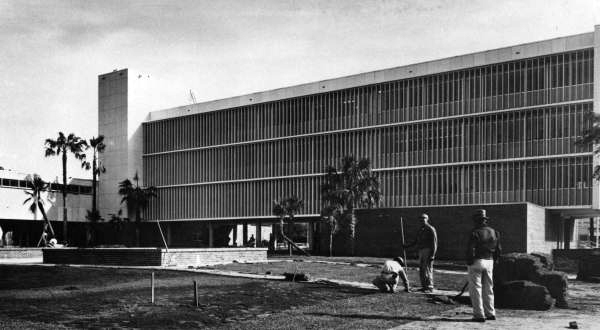 Dedicated in 1962, the new Alachua County Courthouse
was completed at a cost $1.1 million. Within 13 years, it was also deemed insufficient. "... when Alachua County commissioners were “done” with this county’s circa-1885 courthouse in 1960, they leveled it in the name of “progress.” In its place sprung a, sterile, unremarkable utilitarian structure that remains one of downtown’s ugliest buildings to this day." -Ron Cunningham 15 Florida Memory
Dedicated in 1962, the new Alachua County Courthouse
was completed at a cost $1.1 million. Within 13 years, it was also deemed insufficient. "... when Alachua County commissioners were “done” with this county’s circa-1885 courthouse in 1960, they leveled it in the name of “progress.” In its place sprung a, sterile, unremarkable utilitarian structure that remains one of downtown’s ugliest buildings to this day." -Ron Cunningham 15 Florida Memory
 Courthouse Square today. P Marlin January 2022
Courthouse Square today. P Marlin January 2022
Today, only a few relics of the 1885 courthouse and courthouse square remain, the 1885 Seth Thomas clock, the courthouse lions, a horse trough, a yellow fever monument, and a statue honoring Alachua County's Civil War fallen. An original lamppost, similar to the ones that sat in courthouse square, has been preserved and can be viewed at the historic Matheson House on University Avenue (one wonders where the original American Eagle that once topped the old courthouse and the courthouse safe bought by J. Crane in 1959 is today).
The copper lions that graced the courthouse doorways were placed in storage after the courthouse demolition. Then, in the 1970s, they were put on display at the Hague Public Works Office. In 2016, the lions were restored, and one was put on temporary display at the Matheson Museum. The other lion was relocated to the county administration building, where it is displayed today.
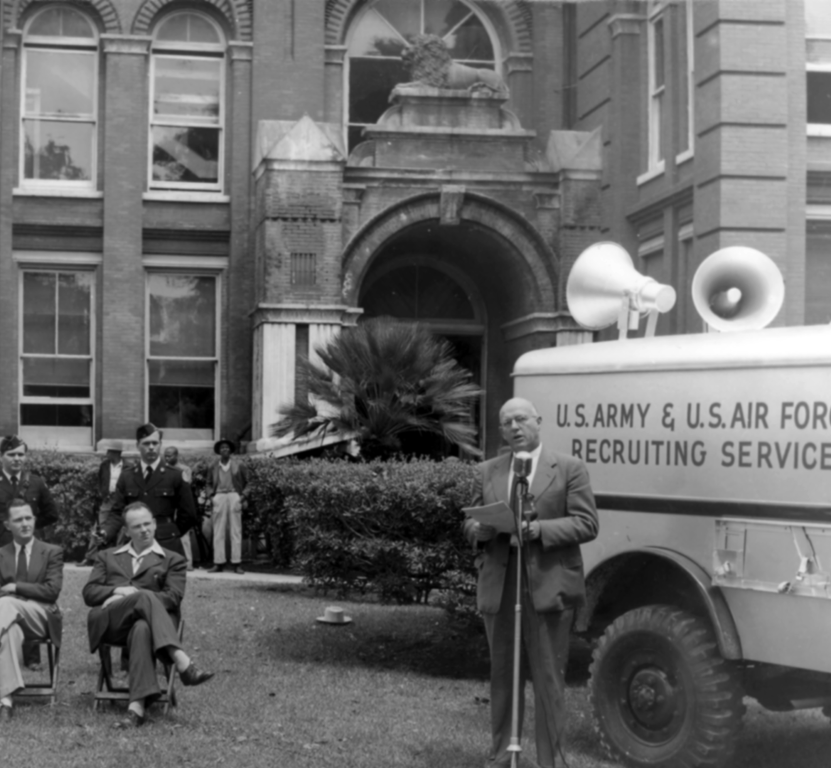 The courthouse lion sits atop the doorway in this photo of an
armed forces recruiting event. University of Florida Digital
Collections
The courthouse lion sits atop the doorway in this photo of an
armed forces recruiting event. University of Florida Digital
Collections
 One of the original courthouse lions on display in the
Alachua County Administration building (the former
courthouse built in 1962). P Marlin
One of the original courthouse lions on display in the
Alachua County Administration building (the former
courthouse built in 1962). P Marlin
Joyce E. Duke donated this horse trough to the Matheson Museum after her father, Davis Goldsmith Edwards, had it removed from the courthouse square in the 1920s. Davis Edwards maintained a livery stable in Gainesville's downtown area. The trough is currently located at the Tison barn on University Avenue, near the Matheson Museum.
 Horse trough from the 1885 courthouse.
Located at the Tison barn near the Matheson Museum. P Marlin
Horse trough from the 1885 courthouse.
Located at the Tison barn near the Matheson Museum. P Marlin
 Horse trough from the 1885 courthouse.
Located at the Tison barn near the Matheson Museum. P Marlin
Horse trough from the 1885 courthouse.
Located at the Tison barn near the Matheson Museum. P Marlin
The Seth Thomas clock was manufactured July 1, 1885 in Thomaston, Connecticut. Brought to Gainesville in an ox cart, it sat atop the courthouse for seventy-six years. In 1983, the clock was installed in a new tower of brick at the corner of NE 1st Street and East University Avenue.
 "Courthouse clock, inside out - That
isn't the customary view of the courthouse clock, one of
Gainesville's best known landmarks. It's the picture
H.L. Coles, jeweler in charge of winding the clock, gets
when he climbs a ladder high into the clock face to adjust
the hands. Gainesville Sun. Matheson Museum archive
"Courthouse clock, inside out - That
isn't the customary view of the courthouse clock, one of
Gainesville's best known landmarks. It's the picture
H.L. Coles, jeweler in charge of winding the clock, gets
when he climbs a ladder high into the clock face to adjust
the hands. Gainesville Sun. Matheson Museum archive
 The 1885 courthouse clock on display in downtown
Gainesville. P Marlin
The 1885 courthouse clock on display in downtown
Gainesville. P Marlin
 The 1885 courthouse clock on display in downtown
Gainesville. P Marlin
The 1885 courthouse clock on display in downtown
Gainesville. P Marlin
 A photo of the same mechanism as above.
"A strong-arm job - It takes elbow grease
to wind the courthouse clock each week, H. L. Coles
has found. He has it down to a system. It takes
240 turns of the crank to wind the striking
mechanism and 100 turns to wind the time."
Gainesville Sun. Matheson Museum archive
A photo of the same mechanism as above.
"A strong-arm job - It takes elbow grease
to wind the courthouse clock each week, H. L. Coles
has found. He has it down to a system. It takes
240 turns of the crank to wind the striking
mechanism and 100 turns to wind the time."
Gainesville Sun. Matheson Museum archive
 "A clock-eyed view - Demolition of the old
Alachua County Courthouse presented an opportunity
for Sun photographer Tommy Lewis to record a rare
clock-eyed view of Gainesville when workmen removed
the ancient tower time piece yesterday. In the
background, the John F. Seagle building rises above
the horizon." Image printed in the Gainesville Sun
on August 29, 1961.
"A clock-eyed view - Demolition of the old
Alachua County Courthouse presented an opportunity
for Sun photographer Tommy Lewis to record a rare
clock-eyed view of Gainesville when workmen removed
the ancient tower time piece yesterday. In the
background, the John F. Seagle building rises above
the horizon." Image printed in the Gainesville Sun
on August 29, 1961.
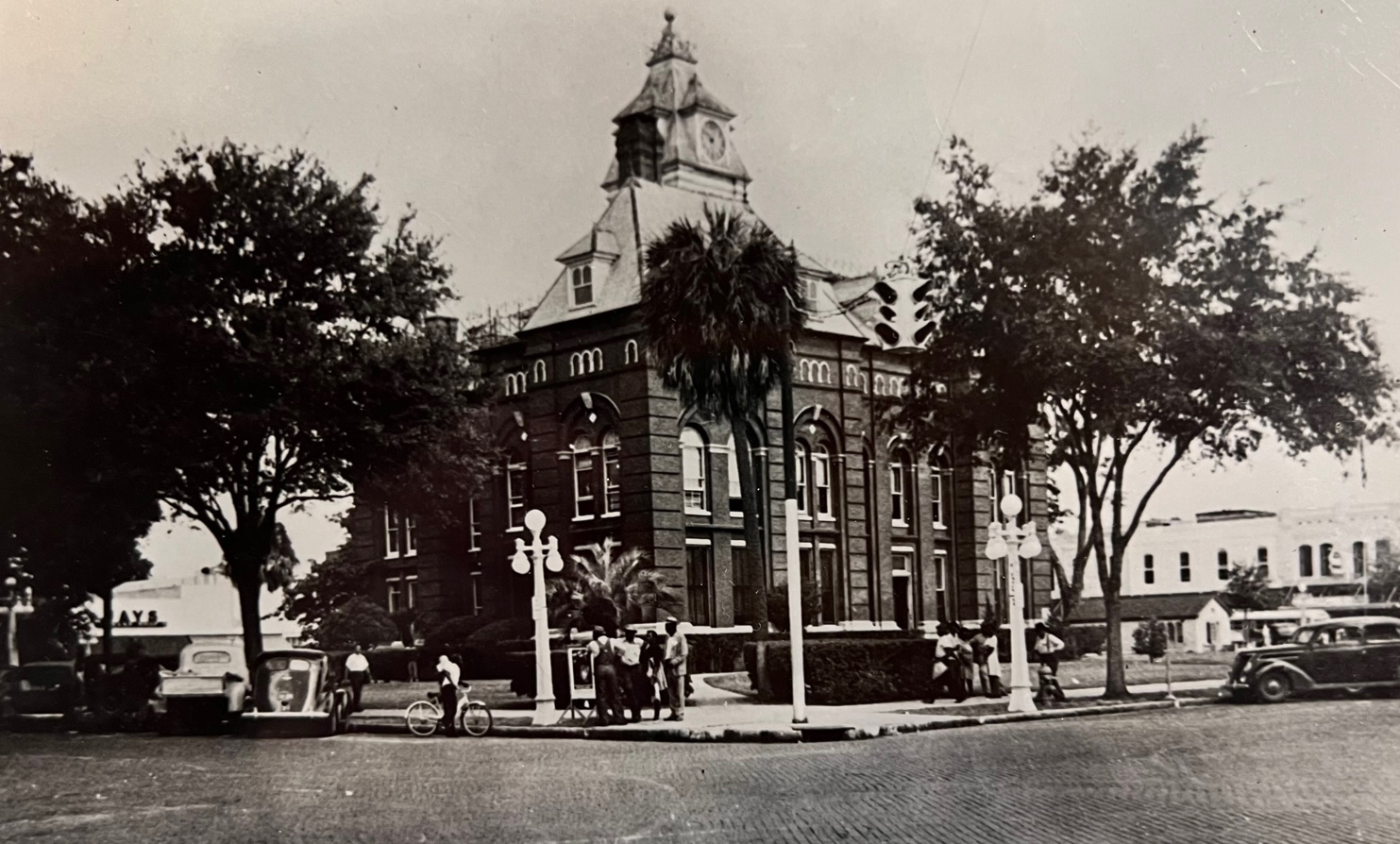 Lampposts at courthouse square. Florida Memory
Lampposts at courthouse square. Florida Memory
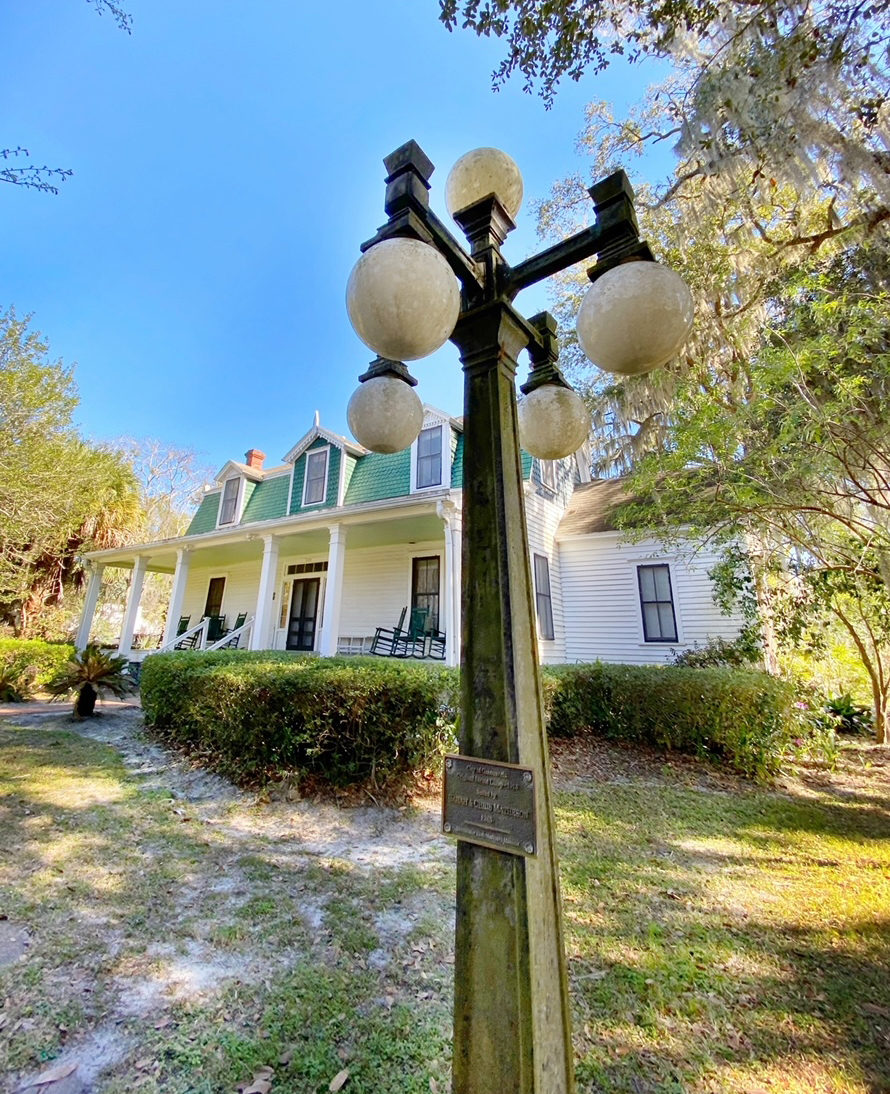 City of Gainesville original lamppost (similar
to the lampposts that stood in courthouse square).
Located at the Matheson House. P Marlin
City of Gainesville original lamppost (similar
to the lampposts that stood in courthouse square).
Located at the Matheson House. P Marlin
The Confederate monument, known as Old Joe, was dedicated at courthouse square in 1904 by the United Daughters of the Confederacy. On August 14, 2017, it was transported to Oak Ridge Cemetery near Rochelle, Florida, a privately owned cemetery in rural Alachua County.
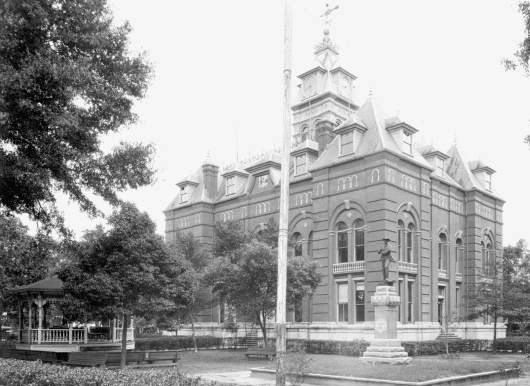 The statue commemorating Alachua County's Civil War dead
(1904) at courthouse square. Florida Memory
The statue commemorating Alachua County's Civil War dead
(1904) at courthouse square. Florida Memory
 The statue commemorating Alachua County's Civil War dead
(1904) is now located at Oak Ridge Cemetery between Rochelle
and Micanopy, Florida. P Marlin
The statue commemorating Alachua County's Civil War dead
(1904) is now located at Oak Ridge Cemetery between Rochelle
and Micanopy, Florida. P Marlin
The following are local opinions reported in the Gainesville Sun.
Should we vote to sell the square?
What is your solution to the courthouse problem?
Keep courthouse square (access requires log-in)
Sense of civic pride (access requires log-in)
Why a new courthouse? Why? (access requires log-in)
Women feel keen on courthouse (access requires log-in)
Keep the old courthouse (access requires log-in)
The courthouse Hangman's Room
Courthouse clock said good for another 100 years (access requires log-in)
Man saved historic clock tower for generations
A relic is restored (horse trough) (access requires log-in)
1 Newnansville a Lost Florida Settlement.
2 Buchholz, Fritz. 1929. History of Alachua County, Florida: narrative and biographical.
3 Alachua County Commissioners meeting. September 6, 1854.
4 Webber, Carl. The Eden of the South. 1883.
5 "Centennial Edition." Gainesville Sun. May 2, 1954
6 "Progress Severs Alachua County's Link to the Past." The Gainesville Sun September 13, 1981
7 The lawyers lead in the courthouse movement. Gainesville Sun. September 26, 1945
8 "Hazard discusses courthouse need." Gainesville Sun. July 3, 1946
9 Commissioners ask study on courthouse. Gainesville Sun. August 17, 1952
10 "City code prevents remodeling of courthouse, Goin tells Jaycees." The Gainesville Sun. July 1, 1955.
11 Matheson Museum Archive
12"Lawyers urge building of new courthouse." Gainesville Sun. April 5, 1955
13 "What's inside a cornerstone?" Gainesville Sun. November 8, 1961
14 "Exact day of city's origins conflicting." Gainesville Sun May 2, 1954
15Cunningham, Ron "Gainesville's downtown destiny." Gainesville Sun April 10, 2005